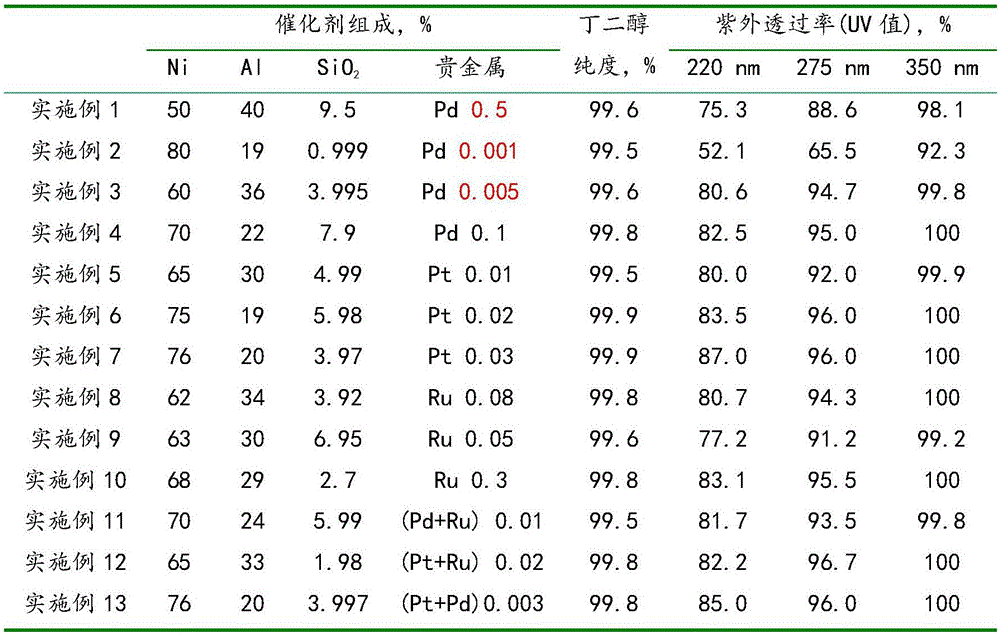Supplementing refining catalyst for preparing 1,4-butanediol, preparation method and application thereof
A supplementary refining and catalyst technology, applied in chemical instruments and methods, physical/chemical process catalysts, metal/metal oxide/metal hydroxide catalysts, etc., can solve the problem of difficult separation of colored impurities, 1,4-butanediol The problem of low purity
- Summary
- Abstract
- Description
- Claims
- Application Information
AI Technical Summary
Problems solved by technology
Method used
Image
Examples
preparation example Construction
[0020] The preparation method of described supplementary refining catalyst comprises the following steps:
[0021] (1) Mix Ni-Al alloy powder with a particle diameter ranging from 10 to 200 μm, binder hydroxypropyl methylcellulose, and silicon source to obtain material I;
[0022] (2) Add deionized water to material I, knead and extrude into strips with a diameter of 2mm, dry and roast to obtain material II;
[0023] (3) Activate the material II with a NaOH solution with a concentration of 1-25%, the activation temperature is 50-100° C., and wash until neutral after activation for 2 hours to obtain the material III;
[0024] (4) The material III is soaked in an aqueous solution containing a noble metal precursor, soaked for 1 hour, and then washed until neutral to obtain the catalyst of the present invention.
[0025] In the preparation method of the supplementary refining catalyst, the silicon source in step (1) is any one of nano silicon dioxide, silica sol, tetraethyl orth...
Embodiment 1
[0035] Catalyst preparation:
[0036] (1) Mix Ni-Al alloy powder with a particle diameter ranging from 10 to 200 μm, binder hydroxypropyl methylcellulose, and nano-silicon dioxide to obtain material I;
[0037] (2) Add deionized water to material I, knead and extrude into strips with a diameter of 2 mm, dry at 100°C for 10 hours, and roast at 700°C for 2 hours to obtain material II;
[0038] (3) Activate the material II with a 1% NaOH solution at an activation temperature of 50° C., activate for 2 hours and then wash until neutral to obtain the material III;
[0039] (4) Immerse the material III in an aqueous solution containing palladium chloride for 1 hour and then wash until neutral to obtain the catalyst of this embodiment.
[0040] Catalyst evaluation:
[0041] The purity of the 1,4-butanediol raw material used in the catalyst evaluation process was 99.0%, and its ultraviolet transmittance (UV value) at 220nm, 275nm, and 350nm were 0.1%, 0.3%, and 34.0%, respectively. ...
Embodiment 2
[0044] Catalyst preparation:
[0045] (1) Mix Ni-Al alloy powder with a particle diameter ranging from 10 to 200 μm, binder hydroxypropyl methylcellulose, and silica sol to obtain material I;
[0046] (2) Add deionized water to material I, knead and extrude into strips with a diameter of 2 mm, dry at 100°C for 10 hours, and roast at 900°C for 2 hours to obtain material II;
[0047] (3) Activate the material II with a NaOH solution with a concentration of 25%, at an activation temperature of 100° C., and wash to neutrality after activation for 2 hours to obtain the material III;
[0048] (4) The material III was soaked in an aqueous solution containing palladium nitrate for 1 hour, and then washed until neutral to obtain the catalyst of this embodiment.
[0049] Catalyst evaluation:
[0050] The purity of the 1,4-butanediol raw material used in the catalyst evaluation process was 99.0%, and its ultraviolet transmittance (UV value) at 220nm, 275nm, and 350nm were 0.1%, 0.3%, a...
PUM
| Property | Measurement | Unit |
|---|---|---|
| Diameter | aaaaa | aaaaa |
Abstract
Description
Claims
Application Information
 Login to View More
Login to View More - R&D
- Intellectual Property
- Life Sciences
- Materials
- Tech Scout
- Unparalleled Data Quality
- Higher Quality Content
- 60% Fewer Hallucinations
Browse by: Latest US Patents, China's latest patents, Technical Efficacy Thesaurus, Application Domain, Technology Topic, Popular Technical Reports.
© 2025 PatSnap. All rights reserved.Legal|Privacy policy|Modern Slavery Act Transparency Statement|Sitemap|About US| Contact US: help@patsnap.com


